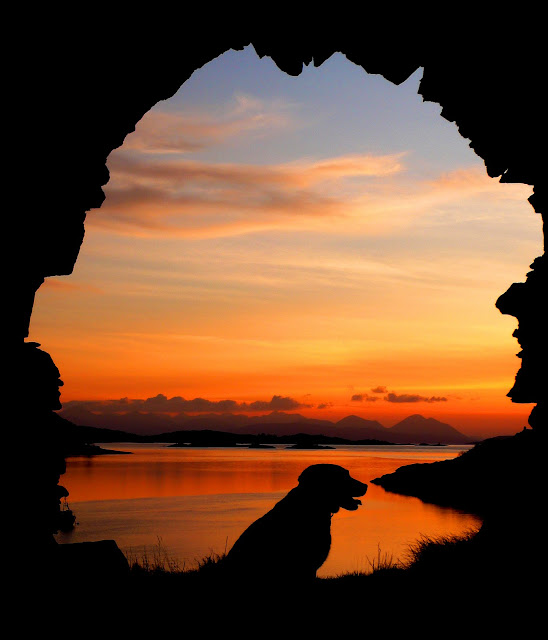all images COPYRIGHT asserted - David Geddes at The Open Sky
Beyond the arch in the ruins of Strome Castle lie the islands at the mouth of Loch Carrann where seals haul out to pup and seabirds nest and fledge. Dolphins cruise to feed mouths facing into the incoming tide. This moves at about 5 knots and when wind assisted can reach 7 knots in the narrows known from the Norse as the 'Straum' - a tidal race. The word has also crossed into the Gaelic. Under the straum runs the Moine Shift - a significant geological fault which pushes the rock structure upwards. The income tide has vertical and horizontal constrictions to negotiate. Its a great place to have fun in a sea kayak.
The next island silhouetted is Raasay. One can cross and visit from Skye which lies behind providing the serrated mountain landscape of the Cuillin mountains, named after Finn McCuill the legendary warrior. Raasay enjoys a much more benign ownership after the barren period of landlord-ism administered by the absent Dr Green. Community buy outs of the old estates are starting to become common enough that we can soon expect the boundaries of bought out estates to co-join. Applecross is close by. Pairc is across the Minch on Lewis. The John Muir Trust and RSPB now have significant land holdings. Glen Moriston recently changed hands to establish a new wild life corridor.
Strome Castle gazes south west. A sea facing arch provides a splendid frame for photographs. This location is found in most landscape photographers stock images. However I live close by. Visiting the castle is one of my late evening dog walking chores. My chocolate Labrador bitch has collie boyfriends close by.
On the beaches either side of the castle rock, the MacDonalds of Glengarry would have pulled out their birlinns. Before them Norse pillagers would have beached their war galleys here. In the early 1600s the MacKenzies and their Kintail kinsmen the McRaes laid siege to this castle, objecting to a Clan Ranald foothold on this part of their mainland. The castle withstood the siege until it is said some womenfolk collecting water from a well, filled a barrel containing all the defenders' gun powder. A bad mistake. Safe passage was subsequently arranged, and the defenders so evicted, the castle was then blown up by the MacKenzies who had retained dry gunpowder!. For the Scottish Highlands of the time, a remarkably bloodless outcome. It was more common for all the defeated defenders to find their heads in the well.
On the nearby Eilean a Fraoch (the small heathery island) guillemots and shags roost in the winter. Otters swim the bay. Occasionally the dolphins chase pollock, salmon and sea trout around the prawn creel boats on their buoys. Herons stalk the tidal fringes. Pine Martens leave little mounds of chewed up rowan berries on conspicuous rocks. Orchids are common. The castle mound is covered in primroses in early spring. One can easily lose one's soul to nature here.







2 comments:
Fantastic!
Stunning! the gloaming, the time between times, is my favourite time of day. I think it is one of those rare moments when we mortals experience enchantment. Twixt two worlds...not quite day, not yet night. Nothing is what it seems, and anything is possible. How beautifully you've captured this eternal dance. Lizzy
Post a Comment